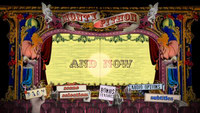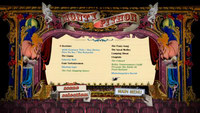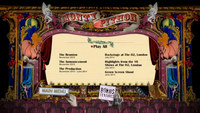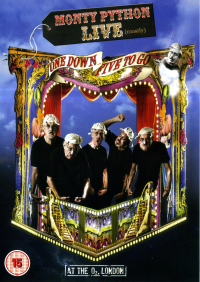
26.11.2014 #587
by Guido Bibra
• The Reunion (November 2013)
• The Announcement (November 2013)
• The Production (November 2013 to June 2014)
• Backstage at the O2, London (July 2014)
• Highlights from the 10 Shows at the O2, London (July 2014)
Plus exclusive footage of the Pythons as Pepperpots & Gumbys
![]() The Show
The Show
They never really wanted to do a reunion, but in the end they decided to do one last great gig. Monty Python, the finest troupe of comedians and satirists ever to appear on stage, television and in cinema, were a little like the Beatles. After 45 television episodes of Monty Python's Flying Circus, four movies and many stage shows they never officially disbanded and continued to work and support each other's projects, but never got back together to do comedy. Although they had a few joint appearances, Michael Palin, Terry Jones, Terry Gilliam, John Cleese and Eric Idle had practically ruled out any chance that Monty Python would reunite after their fellow group member Graham Chapman had passed away in 1989.
It was less a case of not wanting to work together than finding the time to come back together, since the careers of the Pythons had gone in so many different directions since they had slowly stopped working exclusively with each other in the mid-1970s. There were some efforts especially by Eric Idle to do a series of live stage shows at the end of the 1990s, but the five surviving Monty Pythons were never able to completely agree about the project. There may also have been some personal animosities between them, some of which were revealed in their joint 2003 biography, but over the years those seem to have mellowed to a point where a reunion was again something they earnestly talked about again.
To everyone's surprise, the impossible happened in November 2013, when in a veritable media blitz a one-time reunion show was announced for the following summer in London's giant O2 arena. All five surviving Monty Pythons were participating with Graham Chapman joining in in form of archive material, but there was a lot of often nasty media speculation about what had happened to change their minds and if they all were still able to actually do it. Five comedians in their early-to-mid 70s in a huge live show on stage was too much for some journalists to comprehend and the negative comments quickly overwhelmed
What had brought them together in the end was, of course, money, or the lack of it - in 2013 the Python's had been sued by Mark Forstater, one of the producers of Monty Python and the Holy Grail, for back royalties. They had actually lost the case and owed a lot of money, but during a joint Python business meeting, their old friend Jim Beach, to whom they had turned to for advice, made the joke that one show at the O2 would fix their financial troubles for good... and it seems that everyone saw this as the chance to make one last grand stand.
After the announcement in November 2013, many had legitimate doubts that five senior comedians could pull off such a stunt successfully, with some comments from the press being particularly harsh. Their 1980 appearance at the Hollywood Bowl in Los Angeles, subsequently released in 1982 as a feature movie, was a relatively simple affair with black backgrounds as sets and mostly limited to sketches and not much more - it was a representation of their stage work in the 1970s, but became a classic in its own right. The 2014 show had to be of a completely different magnitude and with the driving force of Eric Idle, who had the experience of staging Spamalot and Not the Messiah, behind it, it was to be quite a bit more than just a sketch collection with five septuagenarians tottering around on a bare stage.
Eric Idle's basic idea was, therefore, to mix the good old sketch format with a full-blown Broadway show - a concept that ultimately proved to be the right decision, but was apparently subject of a great debate between the Pythons and it took them a while to all agree. Before the work on the show had even properly started, it had to be sold and that was the purpose of the great announcement at the end of 2013. While the press was rather sceptical and bemused, the response was so overwhelming that all 20.000 seats of the one single show were sold out in less than 45 seconds. This led the Pythons to the agreement that they would do five shows altogether, and when those were also sold in only a short time, their absolutely last offer was ten shows plus the wise decision to broadcast the final night into cinemas worldwide and record it for a later home video release.
At that point, the whole show had yet to be created, which meant six months of very intensive work and preparations, but just two weeks real rehearsal time for the Pythons themselves to make things easier. A generous budget of 4.5 Million Pounds had been set aside from the boxoffice intake, which allowed for really big production numbers - but those still had to be conceived, which mostly fell to Eric Idle after the basics were hammered out by the group. Although it may have looked like Eric Idle was planning a solo show with the other Pythons as guests by taking writing and directing into his own hands, nothing of the sort had happened at all - instead he became the curator and adaptor of their joint heritage.
Although there were no sketches written entirely from scratch, those chosen from the vast amount of Monty Python material were of the finest kind. With a length of over two and a half hours, there was a lot of room for the old numbers in the show, which were represented by almost every audience and fan favourites including not only from the Flying Circus, but also from their last movie The Meaning of Life - quite a few of those were expanded into wonderfully elaborate song-and-dance numbers. All of this still works marvellously and including some additional self-referential references only helped to make the already brilliant material better. To bridge over the moments between scene changes, the live parts of the show were supplemented with excerpts from the television episodes and the movies, some of which had already been used in the Hollywood Bowl show and other parts to highlight Terry Gilliam's animation. They also served one important purpose: to resurrect Graham Chapman, who rejoined his fellow Pythons posthumously for the first and the last time a quarter of a century after his death in a surprisingly respectful way.
Despite their advanced age, with none of them under seventy anymore, the Monty Pythons were in absolute top form on stage. There was, of course, not as much physical action possible as in the old days and the majority of the sketches were performed sitting down, but it all was not just the case of five old comedians stuttering ineptly through their long-forgotten material. Instead, they all proved to be as sharp as a tack with all the old jokes still working brilliantly thanks to their wonderful comedic timing. It was quite apparent that they were all having a blast on stage, only allowing themselves the occasional mistake or forgotten line, quite to the amusement of the audience, who were not laughing at them, but with them. They may be somewhat old and wizened, but the contrast between their younger selves shown in the few sketches from the Flying Circus and their stage appearance was purely visual. Although their voices have deepened over the years, they still sounded as fresh as forty-five years ago and seem to be even more funny.
They also had no reservations about appearing in the most outrageous costumes - while the Hollywood Bowl show was relatively tame in that respect, their final show pulls out all the stops. Led by Terry Gilliam's wife, costume designer Hazel Pethig, who had worked with them since the early Flying Circus times, they change through a veritable multitude of costumes, jumping into every favourite from the many dapper-suited gentlemen, screeching "Pepperpots" housewifes, outrageously flamboyant showmasters and singers and also appearing in full drag costumes on several occasion. In Interviews, they had occasionally referred to it as the final humiliation, but despite the fully intentional ridiculousness of the costumes, they really seem to have had a great time dressing up once again like they had all those years ago.
The Pythons also had some help from an old friend - in many sketches, they were joined by none other than Carol Cleveland, who had appeared as a parody on the dumb blonde stereotype in many Flying Circus episodes and their movies. She had already been brought out of semi-retirement by Eric Idle for the Not the Messiah and despite not being any younger than the Pythons themselves, she was still up for the challenge to fulfil her classic role as the seventh Python.
There was also a sort of new addition to the Python cast - a very talented young stage actor and singer named Samuel Holmes, who had taken over one of the lead roles in Spamalot a few years ago in a British production of the musical and now had the honour of performing with the Pythons on stage, which he mastered brilliantly without completely stealing the show. In addition, a different celebrity guest was invited into each of the ten shows for a sketch and there was also a brilliant pre-recorded sequence with none other than physicists Brian Cox and Stephen Hawking.
Sometimes appearing solo, but often joining the Pythons was a large chorus line of both female and male dancers performing the most amazing routines, which were choreographed by an old friend: Arlene Phillips had already worked with the Monty Pythons on The Meaning of Life, creating two memorable sequences which seem to be the soulmates of the impressive and astonishing dance numbers which would have been quite at home in the original series if only the budget would have allowed it back then. The dance sequences were not the least bit gratuitous, instead they felt like genuine Python material even if they were absent themselves because they were busy changing costumes.
While the Hollywood Bowl show only had pre-recorded music and two appearances from Neil Innes, who was sadly absent now due to some past differences with the Pythons, the new show was graced with a small, but amazing live orchestra. For this, the Python's turned to their old musical collaborator John du Prez, with whom they had worked since Life of Brian together and on their solo projects. Eric Idle had last worked with him on Spamalot and Not A Messiah, where his stage experience came into play. The Pythons had also decided to go with a live orchestra instead of pre-recording to give the show a real live feeling, although the budget and available time did not allow for a full orchestra.
Instead, John du Prez had assembled an amazing jazz-heavy band consisting of himself as conductor and pianist, one woodwind and brass player each, two keyboard players, one guitarist and one bassist and also two musicians on drums and percussion. Together with a small group of vocalists, who added to those singing on stage, the musicians with the decidedly pythonesque name The Genetically Modified Orchestra produced a fantastic sound bringing the old tunes and new numbers to life with a lot of grooving and swinging and the general musical competence that had always been a great trademark of Monty Python.
The frugal, theatre-like setting of the Hollywood Bowl show with its minimal sets simply was no option this time and Terry Gilliam hat set to work to design not only an universal stage background, but also new ideas for each of the sketches. About the only similarity to the Hollywood Bowl was the huge screen in the middle of the stage - enhanced by two more on the sides - which was not only used for the film clips and other graphics, but also to allow the huge audience to see the performers on stage close up. The screen was framed in a wonderful Gilliam creation going back all the way to his early cutout animations, while the sketches were mainly played out on smaller, self-contained stages that had a deliberately simple, low-budget look that resembled the Flying Circus. All this was enhanced by colourful lighting, on-screen graphics and a generally playful atmosphere that made the stage design even more creative.
Altogether ten shows over the course of two separate weeks from July 1 to 5 and 15 to 20 were performed and the final show was not only filmed, but broadcast live on television and into selected cinemas worldwide. Sadly, the BBC, who had even broadcast a documentary about the making of the show, had declined the live broadcast on their regular channels because of the supposed 15 rating, making it unsuitable to simulcast at the time of the performance. Instead, it was shown on the partly BBC-owned Gold channel, which had the disadvantage of not being broadcast on either the Freeview or Freesat, only on the pay-tv Sky network, making this one very unpopular decision from the BBC, which could have been one of the greatest moments in their history.
Bootlegs of the recording were, however, distributed wildly all over the internet and were even available on Youtube, but the show deserved to be seen especially because a home video release was only announced for several months later in November. The film version was expertly directed by Aubrey Powell, who had previously worked to record one performance of Not the Messiah and managed to capture the feeling of the live show amazingly well - it may not have been like being actually there, but it must have been pretty close especially when seen on a large cinema screen. The decision to sell the show on home video too may have been purely financial, but it surely would have been a scandal if it would not have been available to buy.
Overall, this was really the farewell show of the Monty Python's that everyone had been hoping for and nobody actually expected. Michael Palin, Eric Idle, John Cleese Terry Gilliam and Terry Jones didn't act their age at all by being still as funny as ever and even their late friend Graham Chapman was an integral part of the big happening that was lovingly sub titled One Down - Five To Go. Less an overblown extravaganza than a really heartfelt goodbye performance with all the whistles and bells, it may have been inspired by financial woes, but the Monty Pythons didn't phone it in and instead worked hard on bringing all their favourite sketches back one more time. The show turned out to be the perfect finale to their enormous legacy and does not make their previous work superfluous, but is more an introduction to it for a next generation which might not have heard of them before. Monty Python may now have ceased to exist and be an Ex-Comedy-Troupe, but this show makes them immortal.
![]() The DVD
The DVD
After a much too long wait, Monty Python Live (Mostly) - One Down, Five to Go was finally released all over the world on DVD and Blu-Ray in November 2014. It did not come from the BBC or 2Entertain, but from the UK distributor Eagle Rock Entertainment, who mainly specializes in music releases and seems a bit of a strange choice for Monty Python. Although the release has some image quality issues, does not contain any major extras and especially the BBC documentary is notably absent, it is still a nice effort and even comes with a thick booklet.
The DVD reviewed in this article is the British release, but it appears that Eagle Rock has manufactured only one DVD and Blu-Ray for worldwide release, because this UK incarnation also has a German FSK rating printed on the disc, contains a lot of subtitles including German and is completely region-free. Unfortunately the DVD is slightly marred by image quality problems due to being encoded in NTSC and the fact that it is missing a musical interlude after the intermission which was still present in the original television broadcast - which should, however, not be a reason not to buy, because the content is still absolutely first class.
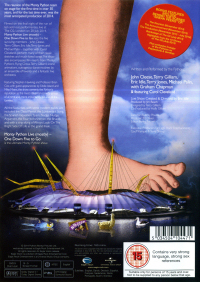
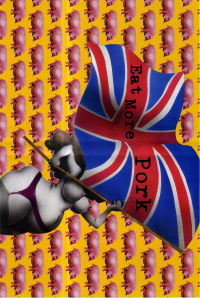
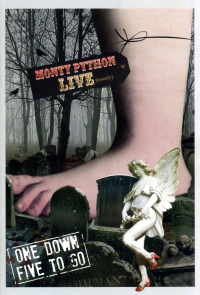

![]() Image
Image
Monty Python Live (Mostly) was originally broadcast on British television in both HD and standard definition with 25fps, but probably to make use of the same image master for DVD and Blu-Ray, this DVD release was encoded in NTSC. Like on the Blu-Ray, which is reportedly also presented in 1080i, this DVD seems to be interlaced and norm-converted from PAL to NTSC, resulting in a surprisingly disappointing quality for a modern release.
At first, the image looks quite good, but there are already signs of heavy ghosting and combing in the very first scenes, which undoubtedly stem from the fact that the 25fps production was squeezed into a 60fps container, which never works well. The only way to play this back properly would be on an interlaced display, which are not really present anymore today - but actually the image looks okay on an older tube television. There is also a surprisingly highly visible amount of aliasing on almost all horizontal edges which looks like a HD-SD conversion gone wrong with an oversharpened image badly downsized. Simply said, this should and could look much, much better and could only have been caused by technical incompetence in the authoring process.
On the positive side, sharpness is very good without obvious artificial enhancements, even with all the ghosting and combing going on. The image has a very nice depth to it, although there is sometimes a slight fluttering or waving visible - but this was already present on the television broadcast and actually seems to have been caused by warm air in the auditorium. Sometimes the camerawork is also a little bit unsteady, which seems to have used a lot of long lenses to get close to the stage without obstructing the views of the audience. There is also not much noise to be seen and the strong colours are reproduced very well without any obvious smearing or bleeding.
Apart from the regrettable PAL-NTSC frame rate conversion and the aliasing issue, the authoring uses a relatively high bitrate and does not produce any visible compression artifacts.
![]() Sound
Sound
The DVD release of Monty Python Live (Mostly) only contains English soundtracks in three different formats - two Dolby Digital tracks in 2.0 and 5.1 and a third 5.1 DTS track. Unfortunately only the first is really listenable.
The 2.0 track seems to be largely the same as the audio from the television broadcast, which already had a really strong stereo-surround mix. The music has a nice, warm, punchy mix occupying the frontal soundstage into both corners with instruments separating astonishingly well for an ad-hoc live production. The speaking and singing voices are anchored mainly in the middle, but have an appropriate depth considering they were recorded live on stage - only the chorus is a bit hard to understand, but this was just the nature of the production and not a fault of the soundtrack itself. The surround channel is liberally used for ambience sound, but in a very unobtrusive and natural way. Overall, this is the soundtrack to listen to on this DVD although it's only in 2.0 - on the Blu-Ray, this is presented as an uncompressed PCM track, but th
The 5.1 track seems to have been newly created for the home video release and sounds completely different than the 2.0 version, although not in a good way. While the mix has been made a little bit more spacious, the discrete surround capability was mainly used to lace especially the voices with such a heavy combination of reverb and echo that this soundtrack is very annoying to listen to. The music is not really heavily affected by this, but the metallic and digitally sounding echo from the dialogue, which is maybe supposed to be what the O2 auditorium sounds like, is so distracting that the 5.1 mix is absolutely useless. I have no way to properly listen to the DTS track, but in a software decoding it sounds practically similar to the Dolby 5.1 track so I have to assume it's the same echo-y mix.
There are subtitles available not only in English, but in a lot of other European languages including German.
![]() Extras
Extras
The bonus material of the DVD release of Monty Python Live (Mostly) is luckily identical to the Blu-Ray version, but there is not really a lot here - mainly some behind-the-scenes material which had already been used in the BBC documentary, which is sadly absent here but can be found on Youtube. The menu design is rather lovingly based on the stage design, but the fonts are a little bit too tiny.
The Reunion - November 2013 (1:10) is a much-too-short extract from a table reading with all five surviving Pythons and Carol Cleveland.
The Announcement - November 2013 (1:56) - This is not the actual announcement, but some behind-the-scenes footage from around the event, which is still wonderful to watch.
The Production - November 2013 to June 2014 (7:58) - A mini-documentary about the making of the show, split up into the parts Musical Arrangement, Choreography, Costume, The Set and Cast & Crew Rehearsal.
Backstage at the O2, London - July 2014 (4:13) is basically what it says on the cover, a rather funny look behind the scenes of the show with many of the performers and other people behind it.
Highlights from the 10 Shows at the O2, London - July 2014 (2:08) contains more behind-the-scenes footage including a couple of celebrities, but only a few shots of the actual stage show. Some additional sketches in other variations would have been nice here.
Green Screen Shoot (5:23) actually has all the footage that was shot for the intermissions with the Pythons playing the 'Pepperpot' ladies and Gumbys, which is some lovely crazy and unhinged stuff.
The Booklet is one of the most surprising extras of the disc - it's only 14 pages long but full of zany Python humour including fake biographies and memories of their earlier stage shows. It seems to be a smaller, condensed version of the large book sold as an expensive special edition of the release, which is a very nice touch considering they could have just left it out altogether.
